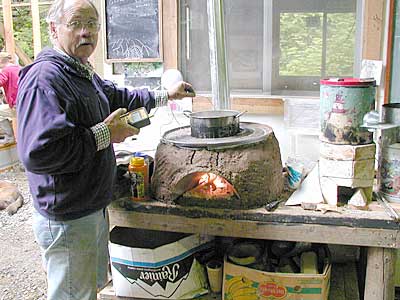Dean Still, June 18 2002
Prototype Ecuadorian earthen stove with Baldwin sheet metal skirt around partially submerged pot.
Dead air space helps to isolate thermal mass from the fire. 29% efficient.
This simple Rocket stove was fabricated and developed with help from Damon Ogle and Jim Wilmes, students at a Aprovecho stove class, beginning June 10, 2002.
Dear Friends,
Thought that it might be interesting for stovers to hear about the findings
of this Spring's two week stove class at Aprovecho. We've had a good time,
kept quite busy and report the following:
1.) Five outdoor tests of the three stone fire, after a lecture on
combustion in the open fire, resulted in an average of 23% efficiency. Pots
were large, ten to twelve inches in diameter, filled with 8,000 to 10,000
grams of water. Folks who want to, can do quite well using an open fire! (In
the field, most folks are not often this careful.) But, in the lab, we find
that admiring traditional technologies only helps to point out how to
improve further developments.
2.) We were asked by a group wanting to build stoves in Ecuador to design a
simple earthen stove with chimney that was as fuel efficient as possible.
Students, Jim Wilmes and Damon Ogle, helped to develop the design, build
prototypes and do the testing of the final stove. The students started with
Sam Baldwin's sheet metal cylinder around the fire cutting a five inch in
diameter fuel magazine hole near the base of the metal cylinder. A four inch
thick cylinder of earth was formed around the 1/2" lower sheet metal skirt
leaving a 3" annular air space between the parallel circular walls. The
sheet metal skirt surrounded the submerged pot leaving a 1/2" gap between
pot and sheet metal. The pot was supported five inches above the fire using
bent rebar...A 55 gallon drum lid fit on top of the earthen wall.
A tight hole cut in the lid allowed the pot to lower into the skirt until it
met the rebar pot support five inches above the fire. A chimney hole was cut
into the metal top as well opposite the arched entrance in the earthen wall
through which sticks enter the hole in the skirt. A hemispherical sheet
metal cone fills the gap between the holes in the sheet metal and earthen
cylinders and supports the earth above the arched opening. Hot flue gases
pass through the 1/2" space between the top of the skirt and the lid and
exit out of the chimney with gratifying speed... (I'll post a picture and
diagram soon.)
Tests show that this stove is 29% efficient. The 3 inches of trapped air
between the sheet metal and earthen wall acts as insulation. The six inch
high 1/2" annular gap between the pot and skirt creates a great chimney
above the fire, resulting in lots of draft. Smoke is removed by the chimney.
I think of this stove as one of the simplest Rocket stoves yet! We hope that
the design ideas are of some use to the team in Ecuador as they adapt local
input into a final design.
3.) Students created a new type of homemade insulative refractory brick by
replacing the sawdust in Ken Goyer's recipe ( two parts regular clay, one
part high fire clay, one part cement, four parts finely sifted sawdust) with
perlite. The bricks were fired in a brick kiln built by the students with
direction by Dr. Larry Winiarski. We plan to continue experiments with
pumice rock in place of combustible material.
4.) Students made five gallon Rocket stoves with three improvements: A.) a
sturdy sheet metal pot support in the shape of a railroad tie, B.) shelves
in the fuel magazine were lengthened toward the user and a support touching
the table top was added to keep the shelf level. C.) A hammer was used to
beat the top of the 5 gallon metal container into a bowl like shape which
helps keep the same cross sectional area beneath pots, assisting heat
transfer dramatically. Using ten to twelve inch pots and 8,000 to 10,000
grams of water these stoves scored an average of 38% efficiency.
5.) Students also helped Larry build his large wood fired agricultural dryer
which we plan to test soon. Lectures and group discussions usually preceded
building and testing designs.
The next one week stove training begins August 23 by which time Dean and
Larry and Ken will have recovered from this very active class!
Best,
Deanتخفيضات

